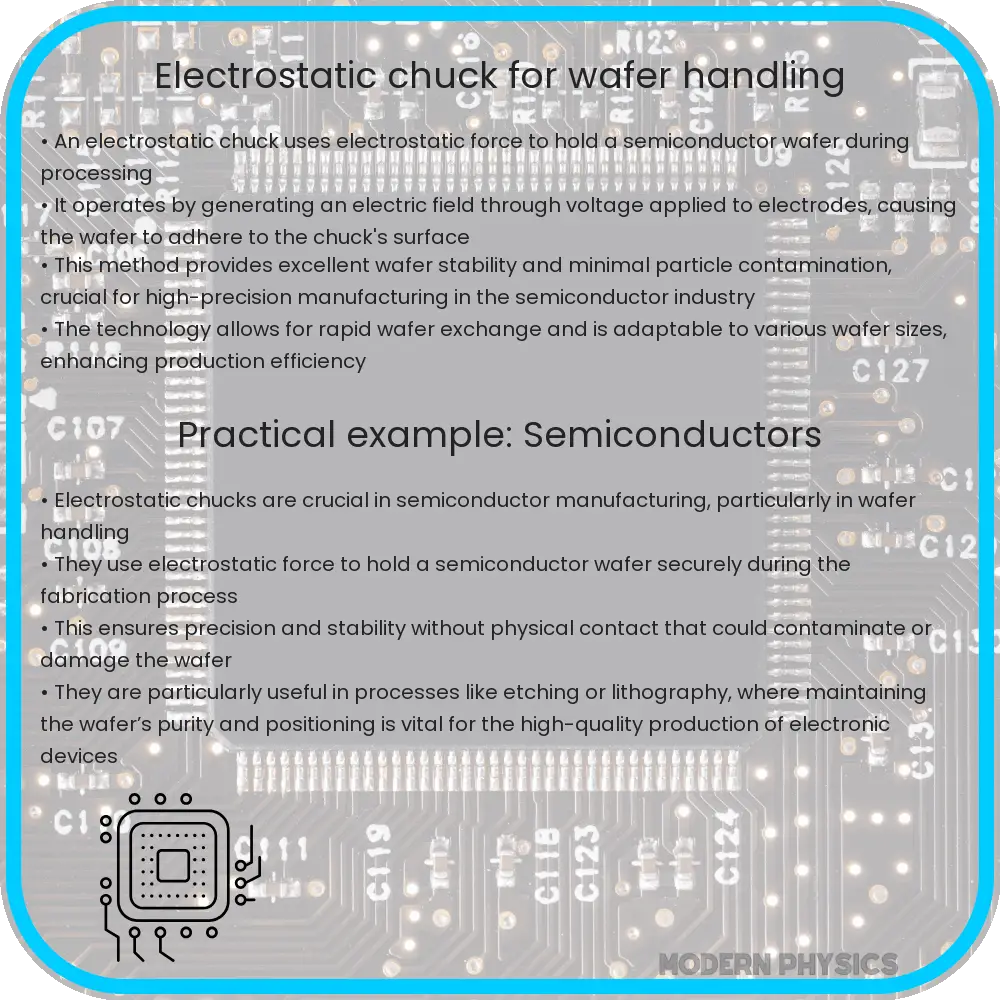Explore the role of Electrostatic Chucks (ESCs) in precision manufacturing, focusing on their advantages, challenges, and future trends.

Understanding Electrostatic Chucks: Enhancing Precision, Safety, and Efficiency
An electrostatic chuck (ESC) is a pivotal component in various high-tech manufacturing processes, particularly in the semiconductor industry. It functions by utilizing electrostatic force to hold objects in place, offering a combination of precision, safety, and efficiency that is essential in delicate and intricate manufacturing environments.
Key Components and Functioning
The fundamental mechanism of an ESC involves creating an electrostatic force between the chuck and the object it holds. This is achieved through the application of a voltage to an electrode embedded within the chuck. There are two main types of electrostatic chucks: Coulombic (Johnsen-Rahbek) and capacitive. The Coulombic type uses a thin dielectric layer, where an electrostatic force is generated due to the attraction between induced charges and the electrode. In contrast, capacitive chucks rely on the electrostatic force generated across a capacitor formed by the chuck, the object, and the dielectric in between.
Advantages in High-Precision Manufacturing
Electrostatic chucks are prized for their ability to handle delicate and ultra-thin wafers with minimal risk of damage. This is particularly important in the semiconductor industry, where the handling of thin silicon wafers is a routine yet critical task. ESCs offer uniform and stable wafer clamping, which is crucial for processes like lithography and etching.
- Precision: ESCs enable precise control over the position and flatness of the wafer, essential for high-resolution patterning.
- Safety: With no moving parts, ESCs reduce the risk of mechanical damage to the wafers.
- Efficiency: By allowing rapid switching between wafers and maintaining a firm grip, they significantly improve throughput.
Technical Enhancements and Materials
The performance of an ESC largely depends on its material composition. Common materials include ceramics like alumina (Al2O3) and polyimide. These materials are chosen for their electrical properties, thermal stability, and chemical resistance, which are crucial for maintaining performance under the harsh conditions of semiconductor processing.
Recent advancements have focused on improving the uniformity of electrostatic force distribution and reducing the voltage required for operation, enhancing both efficiency and safety.
Challenges and Solutions in Electrostatic Chuck Technology
Despite their advantages, electrostatic chucks face challenges, particularly in heat management and particle contamination. In high-temperature processes, maintaining chuck and wafer temperature uniformity is crucial. Advanced ESCs incorporate cooling channels or heaters to regulate temperature. Particle contamination, which can lead to defects in semiconductor devices, is addressed through cleanroom technologies and ESC surface treatments that minimize particle adhesion.
Integration with Automation and IoT
Another emerging trend in the application of ESCs is their integration with automation and the Internet of Things (IoT). Smart manufacturing processes equipped with ESCs can benefit from real-time data monitoring, predictive maintenance, and enhanced process control. This integration not only boosts efficiency but also ensures consistent quality in high-volume production environments.
Environmental Impact and Sustainability
Environmental considerations are also shaping the development of ESCs. Manufacturers are increasingly focusing on reducing power consumption and using environmentally friendly materials. This shift not only aligns with global sustainability goals but also reduces operational costs.
Future Prospects
The future of electrostatic chuck technology is closely tied to the advancements in semiconductor manufacturing and other high-tech industries. As the demand for smaller, more powerful electronic devices grows, so does the need for more precise and reliable manufacturing tools. Innovations in ESC technology, such as improved material compositions and integration with smart manufacturing systems, are set to play a pivotal role in meeting these demands.
Conclusion
Electrostatic chucks represent a critical technology in precision manufacturing, striking a balance between safety, efficiency, and precision. As the semiconductor and related industries evolve, the role of ESCs becomes increasingly significant. Their continued innovation, addressing challenges like heat management and particle contamination, and adapting to trends like IoT integration and environmental sustainability, is essential. The future of electrostatic chucks looks promising, with their potential to further revolutionize high-tech manufacturing processes, contributing to the advancement of technology at a global scale.
